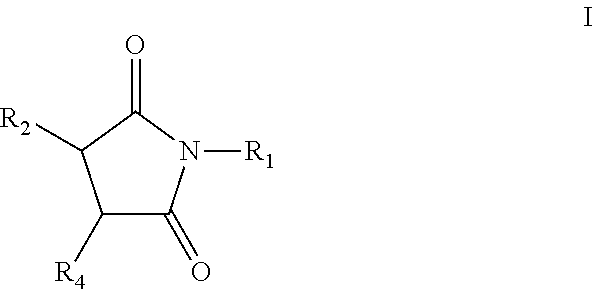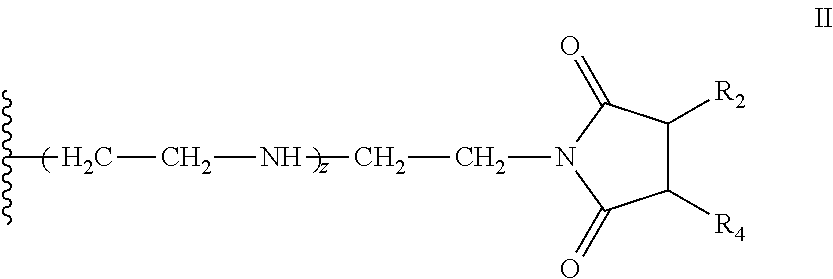Pyrrolidine-2,5-dione derivatives for use in friction modification
a technology of pyrrolidine and derivatives, applied in the field of lubricant additives, can solve the problems failure to meet durability testing, and unacceptably high bv 40 values of finished lubricants having a high level of conventional friction modifiers, so as to improve the low temperature viscometric properties of lubricating fluids, improve the low temperature viscometric performance of fluids, and improve the effect of low temperature viscometric properties
- Summary
- Abstract
- Description
- Claims
- Application Information
AI Technical Summary
Benefits of technology
Problems solved by technology
Method used
Image
Examples
example 1
[0428]
[0429]339.4 grams of C20-C24 olefin (1.1 mol), containing approximately forty (40) wt. % internal vinylidene, 112.8 grams (1.2 mol) of molten maleic anhydride, 2.42 grams p-toluenesulfonic acid (TsOH), and 1.64 grams of synthetic antioxidant (a hindered phenol antioxidant) were charged into a 1.0 L autoclave. The stirred mixture was subjected to vacuum (28 inches of Hg), nitrogen flush, and vacuum cycle as it was heated with stirring. After about 5 hours at a temperature of about 225° C. the resulting alkyl succinic anhydride was transferred to a separate reactor where unreacted maleic anhydride was removed by distillation. Ammonia gas (16.95 grams) was bubbled into the stirred mixture at about 160° C. over the course of from about 2 to about 3 hours. The hot mixture was vacuum filtered to provide a clear product containing 2.29% N. Infrared spectrum of the clear product showed carbonyl bands at 1771, 1709 cm−1 (imide). The amount of acidic groups titratible with a strong base...
example 2
[0430]
[0431]450.0 grams of linear alpha C20-C24 olefin (1.5 mol), 149.6 grams (1.5 mol) of molten maleic anhydride, 3.21 grams p-toluenesulfonic acid (TsOH), and 2.20 grams of synthetic antioxidant (a hindered phenol antioxidant) were charged into a 2.0 L autoclave. The stirred mixture, which was sealed under vacuum, was stirred and heated for about 5 hours at 225° C. The resulting alkyl succinic anhydride was transferred to a separate reactor where unreacted maleic anhydride was removed by distillation. A portion of this intermediate product (99.0 grams) was neutralized with ammonia gas (4.21 grams) at 160° C. to produce 98.8 grams of the succinimide that contained 2.94% N. A representative isomerized linear C20 succinimide structure includes (E)-3-(icos-8-en-8-yl)pyrrolidine-2,5-dione, shown above.
example 3
[0432]
[0433]344.9 grams of C20-C24 olefin (1.1 mol), containing approximately forty (40) wt. % internal vinylidene, 114.6 grams (1.2 mol) of molten maleic anhydride, 2.46 grams p-toluenesulfonic acid (TsOH), and 1.67 grams of synthetic antioxidant (a hindered phenol antioxidant) were charged into a 1.0 L autoclave. The stirred mixture was subjected to vacuum (28 inches of Hg), nitrogen flush, and vacuum cycle as it was heated with stirring. After about 5 hours at about 225° C., the resulting alkyl succinic anhydride was transferred to a separate reactor where unreacted maleic anhydride was removed by distillation. The product was diluted with 45.0 g of process oil. Drop-wise addition of 43.9 grams of commercial tetraethylenepentamine (TEPA) under temperature controlled conditions produced a mixture that was stirred at 160° C., under vacuum for 3 hours. The product (258.5 g) contained 6.09% N and had a total base number (TBN) of 146.5 mg KOH / g. A representative vinylidene C20 bis-suc...
PUM
| Property | Measurement | Unit |
|---|---|---|
| temperature viscometrics property | aaaaa | aaaaa |
| temperature | aaaaa | aaaaa |
| viscosity | aaaaa | aaaaa |
Abstract
Description
Claims
Application Information
 Login to View More
Login to View More - R&D
- Intellectual Property
- Life Sciences
- Materials
- Tech Scout
- Unparalleled Data Quality
- Higher Quality Content
- 60% Fewer Hallucinations
Browse by: Latest US Patents, China's latest patents, Technical Efficacy Thesaurus, Application Domain, Technology Topic, Popular Technical Reports.
© 2025 PatSnap. All rights reserved.Legal|Privacy policy|Modern Slavery Act Transparency Statement|Sitemap|About US| Contact US: help@patsnap.com



